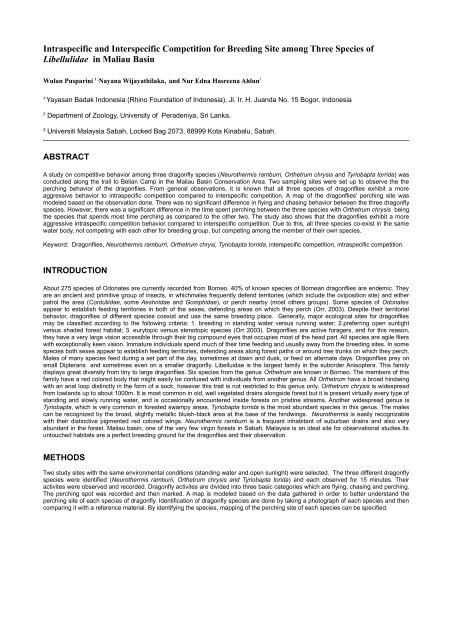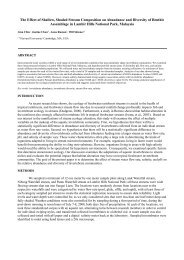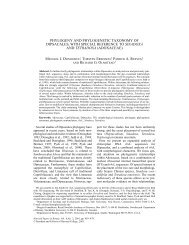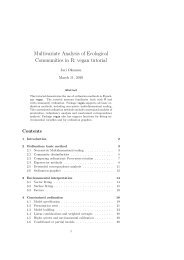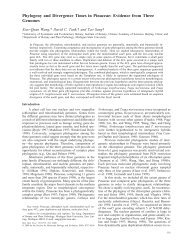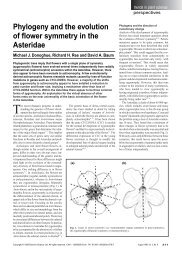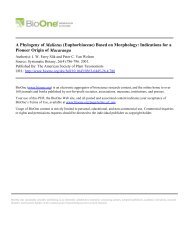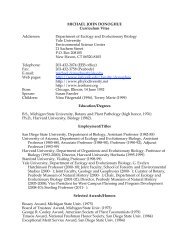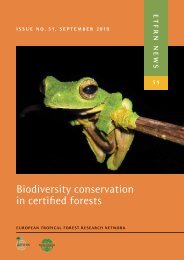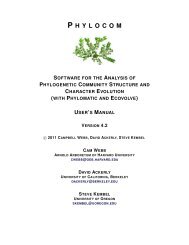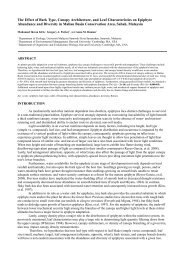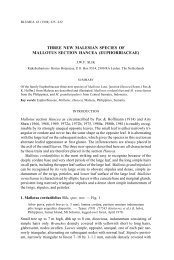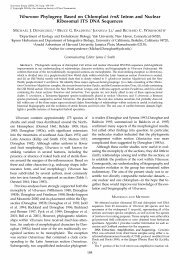Intraspecific and Interspecific Competition for Breeding Site among ...
Intraspecific and Interspecific Competition for Breeding Site among ...
Intraspecific and Interspecific Competition for Breeding Site among ...
Create successful ePaper yourself
Turn your PDF publications into a flip-book with our unique Google optimized e-Paper software.
<strong>Intraspecific</strong> <strong>and</strong> <strong>Interspecific</strong> <strong>Competition</strong> <strong>for</strong> <strong>Breeding</strong> <strong>Site</strong> <strong>among</strong> Three Species ofLibellulidae in Maliau BasinWulan Pusparini 1 , Nayana Wijayathilaka, <strong>and</strong> Nur Edna Hasreena Ahlun 31Yayasan Badak Indonesia (Rhino Foundation of Indonesia), Jl. Ir. H. Ju<strong>and</strong>a No. 15 Bogor, Indonesia2Department of Zoology, University of Peradeniya, Sri Lanka.3Universiti Malaysia Sabah, Locked Bag 2073, 88999 Kota Kinabalu, Sabah.ABSTRACTA study on competitive behavior <strong>among</strong> three dragonfly species (Neurothermis ramburri, Orthetrum chrysis <strong>and</strong> Tyriobapta torrida) wasconducted along the trail to Belian Camp in the Maliau Basin Conservation Area. Two sampling sites were set up to observe the theperching behavior of the dragonflies. From general observations, it is known that all three species of dragonflies exhibit a moreaggressive behavior to intraspecific competition compared to interspecific competition. A map of the dragonflies' perching site wasmodeled based on the observation done. There was no significant difference in flying <strong>and</strong> chasing behavior between the three dragonflyspecies. However, there was a significant difference in the time spent perching between the three species with Orthetrum chrysis beingthe species that spends most time perching as compared to the other two. The study also shows that the dragonflies exhibit a moreaggressive intraspecific competition behavior compared to interspecific competition. Due to this, all three species co-exist in the samewater body, not competing with each other <strong>for</strong> breeding group, but competing <strong>among</strong> the member of their own species.Keyword: Dragonflies, Neurothermis ramburri, Orthetrum chrysi, Tyriobapta torrida, interspecific competition, intraspecific competition.INTRODUCTIONAbout 275 species of Odonates are currently recorded from Borneo. 40% of known species of Bornean dragonflies are endemic. Theyare an ancient <strong>and</strong> primitive group of insects, in whichmales frequently defend territories (which include the oviposition site) <strong>and</strong> eitherpatrol the area (Corduliidae, some Aeshnidae <strong>and</strong> Gomphidae), or perch nearby (most others groups). Some species of Odonatesappear to establish feeding territories in both of the sexes, defending areas on which they perch (Orr, 2003). Despite their territorialbehavior, dragonflies of different species coexist <strong>and</strong> use the same breeding place. Generally, major ecological sites <strong>for</strong> dragonfliesmay be classified according to the following criteria: 1. breeding in st<strong>and</strong>ing water versus running water; 2.preferring open sunlightversus shaded <strong>for</strong>est habitat; 3. eurytopic versus stenotopic species (Orr 2003). Dragonflies are active <strong>for</strong>agers, <strong>and</strong> <strong>for</strong> this reason,they have a very large vision accessible through their big compound eyes that occupies most of the head part. All species are agile flierswith exceptionally keen vision. Immature individuals spend much of their time feeding <strong>and</strong> usually away from the breeding sites. In somespecies both sexes appear to establish feeding territories, defending areas along <strong>for</strong>est paths or around tree trunks on which they perch.Males of many species feed during a set part of the day, sometimes at dawn <strong>and</strong> dusk, or feed on alternate days. Dragonflies prey onsmall Dipterans <strong>and</strong> sometimes even on a smaller dragonfly. Libelluidae is the largest family in the suborder Anisoptera. This familydisplays great diversity from tiny to large dragonflies. Six species from the genus Orthetrum are known in Borneo. The members of thisfamily have a red colored body that might easily be confused with individuals from another genus. All Orthetrum have a broad hindwingwith an anal loop distinctly in the <strong>for</strong>m of a sock, however this trait is not restricted to this genus only. Orthetrum chrysis is widespreadfrom lowl<strong>and</strong>s up to about 1000m. It is most common in old, well vegetated drains alongside <strong>for</strong>est but it is present virtually every type ofst<strong>and</strong>ing <strong>and</strong> slowly running water, <strong>and</strong> is occasionally encountered inside <strong>for</strong>ests on pristine streams. Another widespread genus isTyriobapta, which is very common in <strong>for</strong>ested swampy areas. Tyriobapta torrida is the most abundant species in this genus. The malescan be recognized by the broad, slightly metallic bluish-black area at the base of the hindwings. Neurothermis is easily recognizablewith their distinctive pigmented red colored wings. Neurothermis ramburri is a frequant inhabitant of suburban drains <strong>and</strong> also veryabundant in the <strong>for</strong>est. Maliau basin, one of the very few virgin <strong>for</strong>ests in Sabah, Malaysia is an ideal site <strong>for</strong> observational studies.Itsuntouched habitats are a perfect breeding ground <strong>for</strong> the dragonflies <strong>and</strong> their observation.METHODSTwo study sites with the same environmental conditions (st<strong>and</strong>ing water <strong>and</strong> open sunlight) were selected. The three different dragonflyspecies were identified (Neurothermis ramburii, Orthetrum chrysis <strong>and</strong> Tyriobapta torida) <strong>and</strong> each observed <strong>for</strong> 15 minutes. Theiractivites were observed <strong>and</strong> recorded. Dragonfly activites are divided into three basic categories which are flying, chasing <strong>and</strong> perching.The perching spot was recorded <strong>and</strong> then marked. A map is modeled based on the data gathered in order to better underst<strong>and</strong> theperching site of each species of dragonfly. Identification of dragonfly species are done by taking a photograph of each species <strong>and</strong> thencomparing it with a reference material. By identifying the species, mapping of the perching site of each species can be specified.
RESULTSFrom the results obtained, a map of perching sites of each individual belonging to the three species can be mapped (Figure 1 to 4) <strong>and</strong>compared with each other. The perching area of each individuals overlapped each other. However, even though the areas do overlap,the three species do not exhibit interspecific competition with each other. The intraspecific competition is greater than the interspecificcompetition that enables all these three species to co-exist in the same area.Figure 1 Perching site of three dragonfly species, site A day 1.Figure 2 Perching site of three dragonfly species, site A day 2
Figure 3 Perching site of three dragonfly species, site B day 1Figure 4 Perching site of three dragonfly species, site B day 2Comparison between the three different dragonfly species were tested using the Kruskal-wallis analysis to better underst<strong>and</strong> therelationship. From the analysis only the perching behavior of the species shows a significant difference from each other. The p value <strong>for</strong>perching is 0.0179 that enables us assume that all three species have a significant difference in perching time. However, no significantdifferences were detected in flying <strong>and</strong> chasing behavior between the different species. Boxplots <strong>for</strong> flying, chasing <strong>and</strong> perchingactivities exhibited by the three different species were plotted to better represent the data recorded (Figure 5).
.Figure 5 Boxplot of flying, chasing <strong>and</strong> perching activities of three different species of dragonflies.DISCUSSIONFrom the data recorded, there is indeed a significant difference in perching behavior of the three different species ofdragonflies. Neurothermis ramburii spends more time perching compared to the other two species. From the boxplot (Figure 5),Orthetrum chrysis spends more time chasing compared to the other two species, while Neurothermis spends more time flying. All threespecies have different perching time budget with respect to each other.Based on the observation conducted, female dragonflies do not perch near the site. The site selected was identified asbreeding ground <strong>for</strong> the dragonflies. Mating generally takes places at the breeding site <strong>and</strong> the mating behavior is very complex..Female dragonflies probably perch in the vicinity of the breeding area, <strong>and</strong> only pass by or visit the site to mate <strong>and</strong> breed. Duringobservations, male dragonflies were abundant, but very few females were present. Females are usually only present during mating <strong>and</strong>while laying their eggs. This supports the assumption that the female perches a bit far from the breeding area.The male behavior towards other males belonging to the same or different species exhibits intraspecific <strong>and</strong> interspecificcompetition. <strong>Interspecific</strong> competition is that individuals of one species will suffer in a <strong>for</strong>m of resource reduction due to the presence ofindividuals from a different species. Individuals of different species can compete. When two species compete, individuals of one or bothspecies may suffer reductions in fecundity or survivorship. The fittest individuals of each may be those that escape competitionbecause they utilize the habitat in ways that differ most from those adopted by individuals of the other species. Two species will evolveto become more different from one another than they were previously, they will compete less, <strong>and</strong> thus will be more likely to coexist.<strong>Interspecific</strong> competition is frequently highly asymmetric, <strong>and</strong> the consequences often not the same <strong>for</strong> both species. <strong>Intraspecific</strong>competition is however typically more intense than interspecific competition. Most insect populations that compete <strong>for</strong> limited resourcesprobably exhibit competition, with some individuals obtaining a greater proportion of resources than others suffering someconsequences of deceiving resource availability. If intraspecific competition is generally a more powerful than interspecific competition,
then coexistence <strong>among</strong> competing species will occur simply because populations will limit their own populations growth be<strong>for</strong>ereaching levels at which they exclude their competition. <strong>Intraspecific</strong> competition was indeed often stronger that interspecificcompetition, which lead to all the three species co-exist at the same area, at the same time.From the observation, dragonflies exhibit a more aggressive behavior towards members of the same species compared tomembers <strong>for</strong>m a different species. In the case of Orthetrum chrysis, it shows a very aggressive behavior towards any male of the samespecies that comes to its territory, by chasing it away.This chasing behavior might last <strong>for</strong> a few minutes be<strong>for</strong>e it returns to it's perchingsite. However, if another male of a different species (Neurothermis ramburii or Tyriobapta torida) is present in the area, the Orthetrumchrysis male will not be bothered at all by their presence. They sometime perch very close to each other, but no territorial behavior wasdisplayed. This leads to a conclusion that the male dragonfly is only territorial when it comes to breeding sites. They do not compete <strong>for</strong>food on the given area, but they do compete within their own species <strong>for</strong> mates. Perching area guarded by each male is exclusively <strong>for</strong>mating. And the males becomes aggressive when another male enters his territory as it will lessen its chance to mate with a female.ACKNOWLEDGMENTSMany thanks to Prof. Cam Webb <strong>for</strong> his advice, <strong>and</strong> also to Shawn Lum, Santiago Ramirez <strong>and</strong> Khoo Min Sheng <strong>for</strong> their time <strong>and</strong>meaningful consultation. We would also like to say many thanks to the Maliau Basin Conservation Area, where we conducted ourproject.LITERATURE CITEDBart, J., Fligner, M.A. & Notz, W.I. (2000), Sampling <strong>and</strong> Statistical Methods <strong>for</strong> Behavioral Ecologists, Cambridge University Press.Begon, M., Harper, J.L. & Townsend, C.R. (2003) Ecology 3 rd ed. Blackwell Science.Orr, A.G. (2003), A Guide to the Dragonflies of Borneo, Natural History Publications.Speight, M. R., Hunter, M.D. & Watt, A.D. ( 1999), Ecology of Insects Concepts <strong>and</strong> Application, Blackwell Science.R SCRIPTread.table("dragon.csv", sep=",", header=TRUE)dragon


